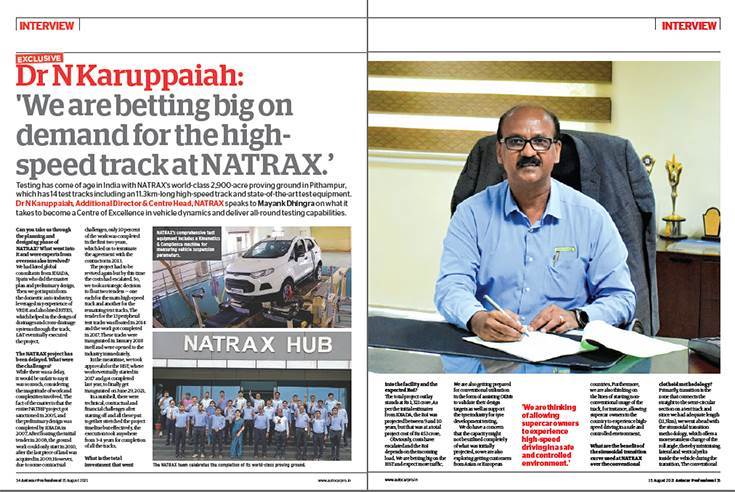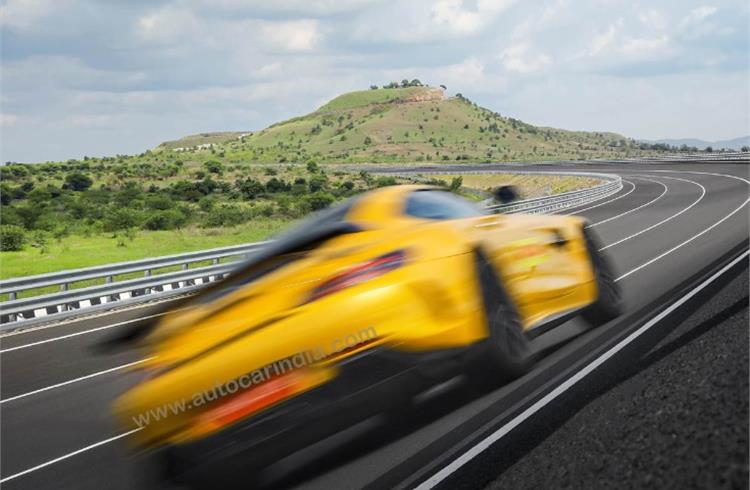Fast and furious: NATRAX’s high-speed track in Pithampur
Testing has come of age in India with NATRAX’s 2,900-acre proving ground in Pithampur which has 14 test tracks including an 11.3km-long high-speed track and state-of-the-art test equipment.
The National Automotive Test Tracks facility or NATRAX which opened its 11.3km-long high-speed track (HST) on June 29, is among the most-advanced test tracks in the world.
The site, located on the outskirts of Indore, in Pithampur, Madhya Pradesh, has been built to support the Indian automotive industry and allow it to test and develop new vehicles by performing various tests like acceleration, high-speed stability, cornering balance, durability and even real-world fuel-efficiency testing.
However, what’s most impressive is the way the track has been built, focusing on the minutest details on the design and construction, to achieve a really high-level of infrastructural finesse. Spanish design and test agency IDIADA is the one behind the preliminary design and master plan of the HST.
After setting India’s first 0-300kph lap time on this world-class facility, we get deeper into the technical details of what’s behind this architectural marvel:
The tarmac
The HST gets a blend of different materials that includes asphalt and polymer-modified bitumen to offer a smooth-as-silk surface for high-speed vehicle testing. The material combination, which is contrasting to a concrete construction, has been achieved in an iterative way, by taking into account the high-ambient temperatures in Madhya Pradesh and longevity.
The track is built to sustain a theoretical life of up to 25 years, but if usage is observed to be very high, it would be resurfaced every 10 years.
Zero gradient
The 2km-long, arrow-straight patch of this test track is absolutely level with the ground with a zero percent longitudinal gradient with surface regularity and evenness to the tolerance level of plus / minus 3mm.
Such stringent specifications took immense engineering brainstorming, and with an altitude difference of 20 metres from one end of the track to the other, the architects had to perform a deep cut of up to 13 metres in depth on one side of the curve, and build an embankment 7-metre high on the other end, in order to meet the zero percent gradient target.
1,000m radius, shallow banking
Another unique feature of the HST is a parabolic curve with a 1,000-metre radius that is designed to allow the driver to hold speeds of up to 250kph, or even more. Contrary to most proving grounds around the world, this section of the track at NATRAX has extremely shallow banking to make the driver feel confident behind the wheel and not lose control in the middle of the corner.
Transition curve
Joining the 2km-long straight with the parabolic or semi-circular curve is a transition zone or transition curve, which gradually connects the two, and allows the driver to continue maintaining high speeds and make the transition in a seamless manner, without experiencing any jerk or mid-corner bumps.
The engineering that has gone into its deployment is a sinusoidal transition methodology, which gradually varies in all the three dimensions to offer a more seamless change of roll angle, thereby, minimising the lateral and vertical jerks felt inside the vehicle during the transition.
The 11.3km length of the track provided scope for a longer transition zone, thereby, allowing the sinusoidal transition curve to be used over the conventional clothoid methodology, which is less seamless and predominantly used for shorter test tracks.
Efficient drainage
With water being an enemy of asphalt, especially on a track which has a deep-cut section of 13 metres in depth, there are high chances of water accumulation under heavy downpour. However, to solve this problem effectively, the HST has special design measures with a total of four lanes of drainage, two on the ground level and two lanes on either side of the pavements and service road.
Moreover, the drainage depth ranges up to 3 metres at the 13-metre cut section to trap more water. National public sector enterprise – RITES – has carried out the drainage and cross-drainage designs of this facility.
ALSO READ:
Interview with Dr N Karuppaiah, Additional Director & Centre Head, NATRAX.

RELATED ARTICLES
BRANDED CONTENT: Eliminating the worries of battery charging with smart solutions
The charging infrastructure is the backbone of electric mobility but is also one of the key perceived barriers to EV ado...
The battery-powered disruptor
Greenfuel Energy Solutions is planning to shake up the EV battery market with the launch of a portfolio of specially eng...
SPR Engenious drives diversification at Shriram Pistons & Rings
The engine component maker is now expanding its business with the manufacturing of motors and controllers through its wh...





 15 Aug 2021
15 Aug 2021
 8563 Views
8563 Views








 Autocar Pro News Desk
Autocar Pro News Desk




